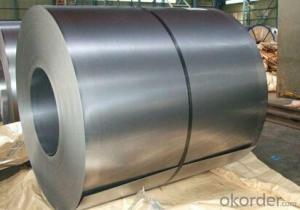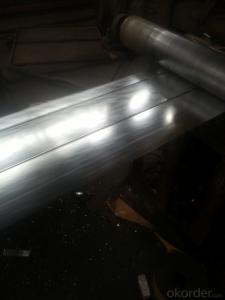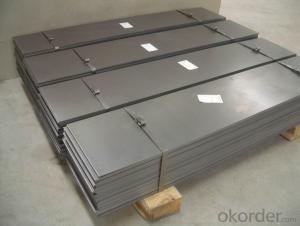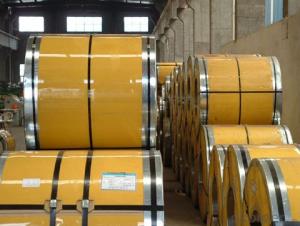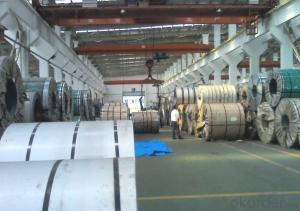Hot-dip Zinc Coating Steel Building Roof Walls Steel Coil ASTM 615-009
- Loading Port:
- Tianjin
- Payment Terms:
- TT OR LC
- Min Order Qty:
- 9999 kg/m²
- Supply Capability:
- 11 kg/m²/month
OKorder Service Pledge
OKorder Financial Service
You Might Also Like
1.Structure of Hot-Dip Galvanized Steel Sheet Description:
Hot-dip galvanized steel coils are available with a pure zinc coating through the hot-dip galvanizing process. It offers the economy, strength and formability of steel combined with the corrosion resistance of zinc. The hot-dip process is the process by which steel gets coated in layers of zinc to protect against rust. It is especially useful for countless outdoor and industrial applications. Production of cold formed corrugated sheets and profiles for roofing, cladding, decking, tiles, sandwich walls, rainwater protective systems, air conditioning duct as well as electrical appliances and engineering.tungsten, carbon and so on. Basically, steel is an iron-carbon alloy that does not undergo eutectic reaction. In contrast,cast iron does undergo eutectic reaction, suddenly solidifying into solid phases at exactly the same temperature. Too little carbon content leaves (pure) iron quite soft, ductile, and weak. Carbon contents higher than those of steel make an alloy, commonly called pig iron, that is brittle (not malleable). While iron alloyed with carbon is called carbon steel, alloy steel is steel to which other alloying elements have been intentionally added to modify the characteristics of steel. Common alloying elements include: manganese, nickel, chromium, molybdenum, boron, titanium, vanadium, tungsten, cobalt, and niobium.[1] Additional elements are also important in steel: phosphorus, sulfur, silicon, and traces of oxygen, nitrogen, and copper.
2.Main Features of the Hot-Dip Galvanized Steel Sheet:
• Excellent process capability
• Smooth and flat surface
• Workability, durability
• Excellent anticorrosive property
• High strength
• Good formability
• Good visual effect
3.Hot-Dip Galvanized Steel Sheet Images

4.Hot-Dip Galvanized Steel Sheet Specification
Standard: ASTM, JIS,EN
Grade: CS, DX51D+Z,SGCC, SS 230~550,S220GD+Z~S550GD+Z, SGC340~SGC570
Thickness: 0.1mm~5mm
Width: max 2000mm
Coil weight:3-12 MT
Coil ID:508/610mm
Surface structure: zero spangle, regular spangle or minimum spangle
Surface treatment: Chromate treatment, Oiled/dry, skinpassed/non-skinpassed
Packing: Standard seaworthy export package
Technology test results:
Processability | Yield strength | Tensile strength | Elongation % | 180°cold-bending |
Common PV | - | 270-500 | - | d=0,intact,no zinc removal |
Mechanical interlocking JY | - | 270-500 | - | d=0,intact,no zinc removal |
Structure JG | >=240 | >=370 | >=18 | d=0,intact,no zinc removal |
Deep drawn SC | - | 270-380 | >=30 | d=0,intact,no zinc removal |
EDDQ SC | - | 270-380 | >=30 | d=0,intact,no zinc removal |
5.FAQ of Hot-Dip Galvanized Steel Sheet
We have organized several common questions for our clients,may help you sincerely:
1.How about your company?
A world class manufacturer & supplier of castings forging in carbon steel and alloy steel,is one of the large-scale professional investment casting production bases in China,consisting of both casting foundry forging and machining factory. Annually more than 8000 tons Precision casting and forging parts are exported to markets in Europe,America and Japan. OEM casting and forging service available according to customer’s requirements.
2.How to guarantee the quality of the products?
We have established the international advanced quality management system,every link from raw material to final product we have strict quality test;We resolutely put an end to unqualified products flowing into the market. At the same time, we will provide necessary follow-up service assurance.
3. How long can we receive the product after purchase?
Usually within thirty working days after receiving buyer’s advance payment or LC. We will arrange the factory manufacturing as soon as possible. The cargo readiness usually takes 15-30 days, but the shipment will depend on the vessel situation.
- Q:Are steel strips used in the production of industrial machinery?
- Yes, steel strips are commonly used in the production of industrial machinery. Steel strips are thin, flat pieces of steel that are often used as a raw material in various manufacturing processes. They are frequently used in the construction of machine components, such as gears, springs, and brackets, due to their strength, durability, and versatility. Steel strips can be shaped, bent, and formed into different configurations to suit the specific requirements of the machinery being produced. Additionally, steel strips can be heat-treated or coated to enhance their performance and protect against corrosion. Overall, steel strips play an important role in the production of industrial machinery and contribute to its quality, reliability, and longevity.
- Q:What are the different surface coating methods for steel strips?
- Some of the different surface coating methods for steel strips include hot-dip galvanizing, electro-galvanizing, metallic coatings, organic coatings, and powder coating.
- Q:What is the typical length of steel strips?
- The typical length of steel strips can vary depending on the specific application, but they are commonly available in lengths ranging from a few feet to several hundred feet.
- Q:How do steel strips perform in electrical circuits?
- Steel strips are not typically used in electrical circuits as they have high electrical resistance compared to other materials, such as copper or aluminum. Therefore, they do not perform well as conductors of electricity and are not commonly utilized in electrical circuit applications.
- Q:How are steel strips classified based on thickness?
- Steel strips are typically classified based on thickness into three main categories: thin, medium, and thick.
- Q:How are steel strips tempered?
- To enhance the mechanical properties of steel strips, a controlled heating and cooling process known as tempering is employed. This involves heating the strips to a specific temperature and then rapidly cooling them. Initially, the steel strips are heated to a temperature below their critical point, usually ranging from 400 to 700 degrees Celsius (752 to 1292 degrees Fahrenheit), depending on the desired outcome. This heat relieves internal stresses caused by previous manufacturing processes like rolling or quenching. Once the desired temperature is reached, the strips are maintained at that temperature for a designated period, which can vary from a few minutes to several hours. This ensures the steel reaches a uniform temperature throughout, guaranteeing consistent tempering. Following the holding time, the strips undergo rapid cooling through methods like air cooling, oil quenching, or water quenching. The rate of cooling plays a crucial role in determining the final properties of the tempered steel, as it influences the microstructure and hardness. The rapid cooling procedure creates a fine-grained microstructure within the steel, improving its toughness, ductility, and resistance to brittleness. The specific cooling method utilized depends on the type of steel and the desired properties. In conclusion, tempering steel strips is an essential manufacturing step to enhance their strength and durability. The controlled heating and cooling process guarantees a balance between hardness and toughness, rendering the steel suitable for various industries, including automotive, construction, and manufacturing.
- Q:How are steel strips tested for internal defects?
- Steel strips are typically tested for internal defects using non-destructive testing methods such as ultrasonic testing or magnetic particle inspection. These techniques involve the use of specialized equipment to detect and analyze any internal flaws or irregularities in the steel strips without causing any damage to the material.
- Q:How are steel strips processed for fire resistance?
- Steel strips can be processed for fire resistance using several methods. One common method is to apply a fire-resistant coating to the surface of the steel strip. This coating is designed to provide a protective barrier that can withstand high temperatures and prevent the steel from reaching its critical temperature, which is the temperature at which it loses its structural integrity. The fire-resistant coating can be applied through various techniques such as spray coating, dip coating, or electrostatic deposition. Another method of processing steel strips for fire resistance is through the application of intumescent coatings. These coatings are designed to expand when exposed to high temperatures, forming a thick and insulating layer that acts as a shield against heat transfer. Intumescent coatings can be applied as a paint or a thin film on the surface of the steel strip. Additionally, steel strips can also be processed for fire resistance through the use of fire-resistant insulation materials. These materials are applied to the steel strip to provide additional insulation and protection against heat. Insulation materials can include mineral wool, ceramic fiber, or vermiculite boards, which are known for their high resistance to fire. It is important to note that the specific process of fire resistance for steel strips may vary depending on the intended application and the required level of fire protection. Therefore, it is essential to consult with experts in the field of fire protection to determine the most suitable method of processing steel strips for fire resistance in a particular scenario.
- Q:How are steel strips cleaned and prepared for coating?
- Steel strips are cleaned and prepared for coating through a multi-step process to ensure effective adhesion and durability of the coating. The first step is usually mechanical cleaning, where the strips are passed through a series of rollers or brushes to remove any loose dirt, rust, or scale. This process helps in creating a clean surface for the subsequent cleaning methods. After mechanical cleaning, the steel strips undergo chemical cleaning, which involves the application of chemical solutions to remove any remaining contaminants. This can include degreasers or alkaline cleaners to dissolve oils, greases, or other organic substances, as well as acid solutions to remove rust or scale. Once the chemical cleaning is complete, the steel strips are rinsed thoroughly to remove any residue from the cleaning agents. This is crucial as any leftover chemicals could interfere with the adhesion of the coating. After rinsing, a process called surface conditioning is performed to further enhance the surface quality. This can involve treatments like pickling, where the steel strips are immersed in an acid solution to remove any remaining oxides or impurities. This step helps in improving the surface roughness and promoting better coating adherence. Finally, the steel strips are dried to remove any moisture before the coating is applied. This can be done through various methods such as hot air drying or passing the strips through heated rollers. Drying is crucial as moisture can lead to poor coating adhesion and cause defects in the finished product. Overall, the cleaning and preparation of steel strips for coating involve a combination of mechanical and chemical methods to ensure a clean, smooth, and properly conditioned surface. This process is vital in achieving a high-quality and long-lasting coating on the steel strips.
- Q:How are steel strips used in the construction of bridges?
- Steel strips are commonly used in the construction of bridges for various purposes, including reinforcement, structural support, and connection between different components. They are often used as reinforcing bars or ties to enhance the strength and durability of concrete structures. Steel strips can also be used as diaphragms or stiffeners to provide additional support and stability to bridge beams. Furthermore, they are utilized in the fabrication of bridge expansion joints, which allow for the natural movement and expansion of the bridge components due to temperature changes. Overall, steel strips play a crucial role in enhancing the structural integrity and longevity of bridges.
1. Manufacturer Overview |
|
|---|---|
| Location | |
| Year Established | |
| Annual Output Value | |
| Main Markets | |
| Company Certifications | |
2. Manufacturer Certificates |
|
|---|---|
| a) Certification Name | |
| Range | |
| Reference | |
| Validity Period | |
3. Manufacturer Capability |
|
|---|---|
| a)Trade Capacity | |
| Nearest Port | |
| Export Percentage | |
| No.of Employees in Trade Department | |
| Language Spoken: | |
| b)Factory Information | |
| Factory Size: | |
| No. of Production Lines | |
| Contract Manufacturing | |
| Product Price Range | |
Send your message to us
Hot-dip Zinc Coating Steel Building Roof Walls Steel Coil ASTM 615-009
- Loading Port:
- Tianjin
- Payment Terms:
- TT OR LC
- Min Order Qty:
- 9999 kg/m²
- Supply Capability:
- 11 kg/m²/month
OKorder Service Pledge
OKorder Financial Service
Similar products
New products
Hot products
Related keywords
